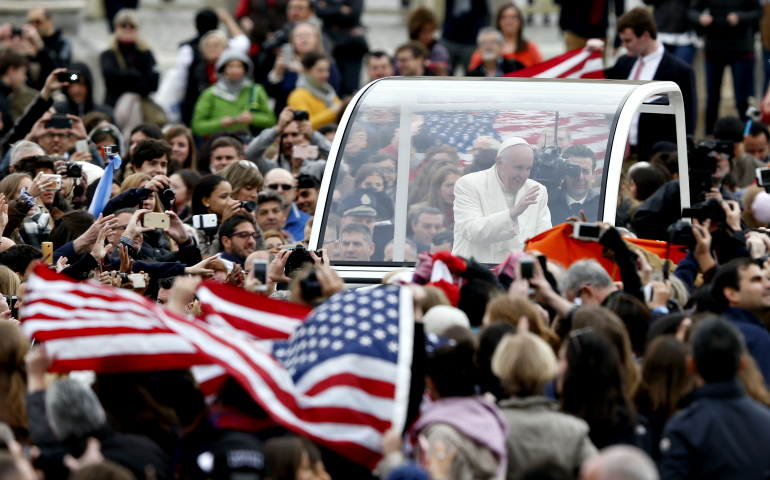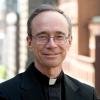
U.S. flags are seen as Pope Francis greets the crowd in St. Peter's Square at the Vatican in March 2016. (CNS/Paul Haring)
Under normal circumstances, it would be possible to predict the series of events that would surround the meeting of a president of the United States and the pope of the Catholic Church.
First, there will be all of the pre-meeting discussions in the media. Predictions will be made about conflicts between the two leaders because of the disagreements that they have. This has been true of almost every meeting between a president and a pope because there are always areas of disagreement.
With Democratic presidents, the disagreements are over birth control, abortion and gay marriage. With Republican presidents, the disagreements are over issues of war and peace and of the responsibility of the government to help the poor and marginalized.
Thus, before the Pope John Paul II met with President Bill Clinton, the prediction was of a public takedown of the president by the pope over abortion. It did not happen. Likewise, when Pope Benedict XVI met with President Barack Obama, some expected the pope lecture the president on abortion and the religious freedom agenda of the U.S. bishops. Did not happen.
Note the predictions of lectures always go in one direction. It is always the pope lecturing the president. No American president has ever dared to lecture the pope. At least, not yet.
It is not surprising that predictions are flying around of a major confrontation when President Donald Trump meets with Pope Francis. The two men hold such diametrically opposed views on the environment, refugees, migrants, diplomacy and the use of military force that it is easy to foresee a blowup. On economics, they both agree that globalization has had negative effects, but Trump is only focused on the U.S., while Francis is focused on developing nations.
The personalities are also known to be unpredictable. Francis has constantly surprised observers, and Trump is so volatile that it is hard to predict what he might do.
When the meeting between a pope and a president finally takes place, there are also other meetings going on between the president's staff and the Vatican Secretariat of State.
There are rarely fireworks accompanying these meetings. The Vatican does not want to embarrass an important leader like the president of the United States. There is no desire to burn bridges. The Vatican has had centuries of experience dealing with political leaders — good and bad, rational and crazy, friend and foe. It wants an ongoing relationship with the world's superpower. It will not risk that for a one-day news cycle.
The actual meetings between presidents and popes are private with only a translator present. Few details ever leak out about what was actually said between the two leaders. But often the tone of the meeting is revealed. For example, after the meeting between Obama and Benedict, the pope shared with others how impressed he was by the president, much to the disappointment of American conservatives.
The lack of information leads Vatican reporters to grasp at straws, for example, watching to see if the meeting goes over the time allotted, which could indicate that the two leaders are getting along or having a serious conversation.
Americans tend to believe the conversations between the popes and presidents and between the presidents' staff and the Vatican Secretariat of State focus on American domestic issues like birth control, abortion and religious freedom, whereas participants report that 90 percent of the discussions are on foreign policy issues, especially the Middle East.
The Vatican is interested in knowing what the American plans are for bringing about peace in the Middle East, what it is saying privately to Israel, and how the Vatican and the United States can work together for peace and development. The issue of refugees would also be on the table.
American diplomats are interested in the Vatican's assessment of other world leaders, and they want to know what the Vatican might say about foreign policy issues like the Middle East, climate change and even genetically modified organisms. Sometimes the Americans want the Vatican's help with a particular leader or country. The staff meetings are professional on both sides.
After the meetings are done, the Vatican issues a brief (a couple of paragraphs) statement listing the topics covered. This is not all that helpful since the statement does not indicate how much time was spent on each topic, let alone what was said. Since both sides already have publicly stated positions on the issues, it is not hard to guess. Some Vatican officials, even those who did not participate, will try to anonymously spin the story for their own purposes, which can lead to different interpretations of the meetings.
The vagueness of the Vatican press releases can lead to misinterpretations of the meetings. For example, after a meeting between U.S. Secretary of State John Kerry and Vatican officials in January 2015, there was one line about health care in the press release. This became the headline in most media stories, since the conflict between the American bishops and the Obama administration over the contraceptive mandate was well-known. In reality, participants said that the Vatican brought up the topic at the request of the American bishops and only spent about five minutes on it. The overwhelming time was devoted to foreign policy.
U.S. officials also play up the positive when talking to the press after the meetings. No administration has seen any advantage to being portrayed as in conflict with the pope. Sometimes, they are tempted to go overboard on stressing agreement where there was none, which may lead to a polite clarification from the Vatican press office.
Thus, normally a meeting between a pope and a U.S. president has little fireworks. Both sides play down conflict and emphasize the professional quality of the discussions.
But this president is not "no-drama Obama." Nor is the pope the academic Benedict.
With Trump, we don't know what we will get, although his meetings with foreign leaders have gone pretty well so far. But he could come out of the meeting with the pope and immediately tweet, "Pope Great Guy! He and I AGREE on EVERYTHING! GOOD! We will save the world!"
Or worse yet: "Cryin' Pope Francis ... not a fan of walls. Low-energy. 7/10 as far as popes go. Asked me to pray for him. I'm very busy. SAD."
(In the comment section below, please tell us what you think the Donald will tweet after meeting the pope.)
Nor are we sure what Francis will say. He has yet to misstep in any of his encounters with foreign leaders. He respects the advice he gets from the Vatican diplomats. He is not directly confrontational.
On the other hand, this is a man comfortable with going off-script. He is also known to have the typical Latin American suspicion of the United States government and business. His disagreements with Trump are clear.
The odds are that there will be more drama leading up to the meeting than at the meeting, but with Trump and Francis, you never know.
[Jesuit Fr. Thomas Reese is a senior analyst for NCR and author of Inside the Vatican: The Politics and Organization of the Catholic Church. His email address is treesesj@ncronline.org.]
Editor's note: We can send you an email alert every time Thomas Reese's column, Faith and Justice, is posted. Go to this page and follow directions: Email alert sign-up.




